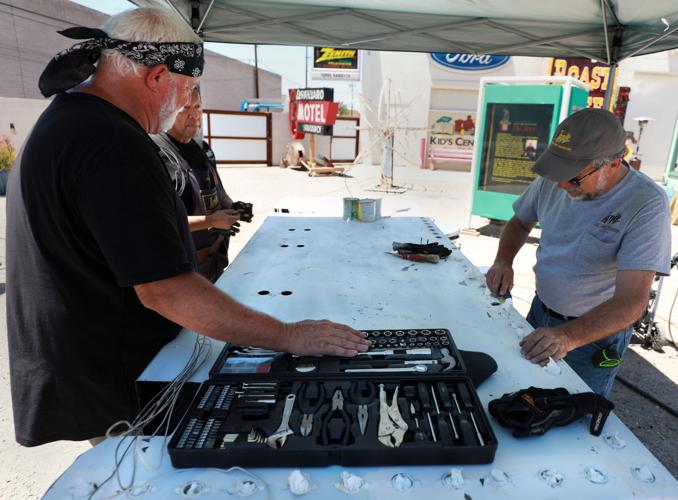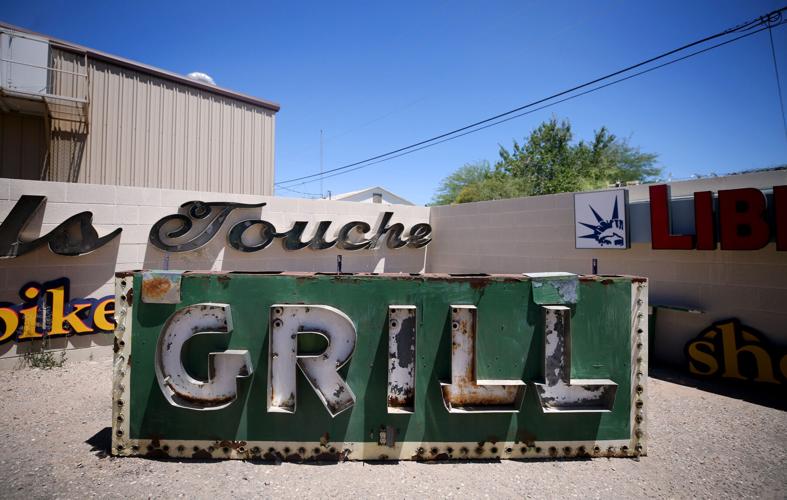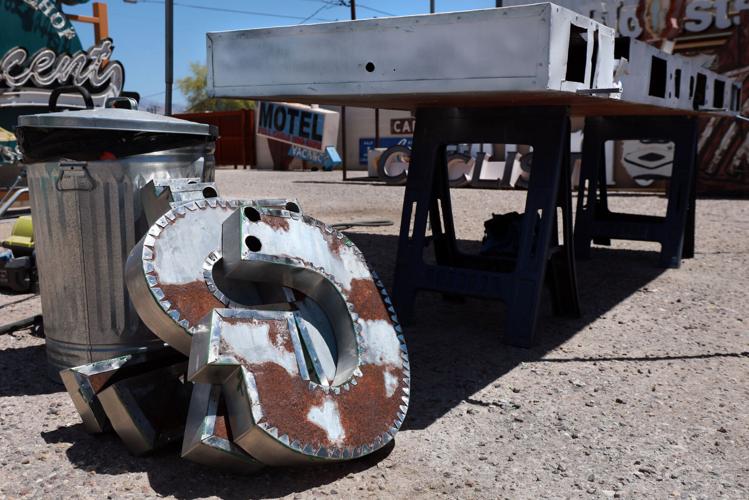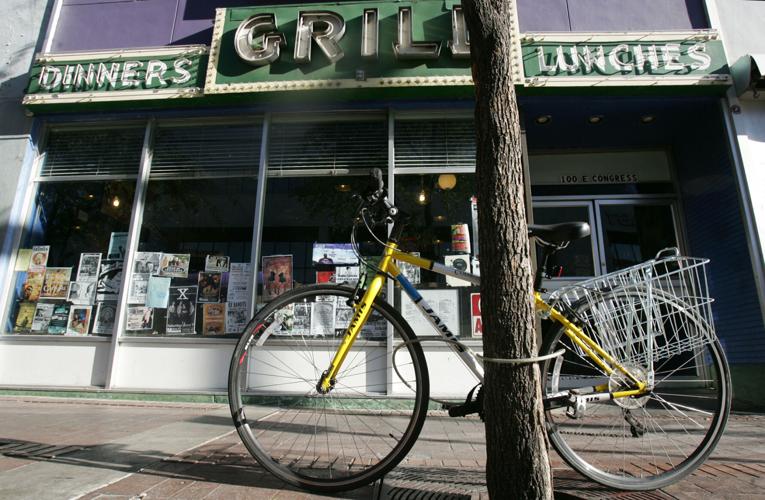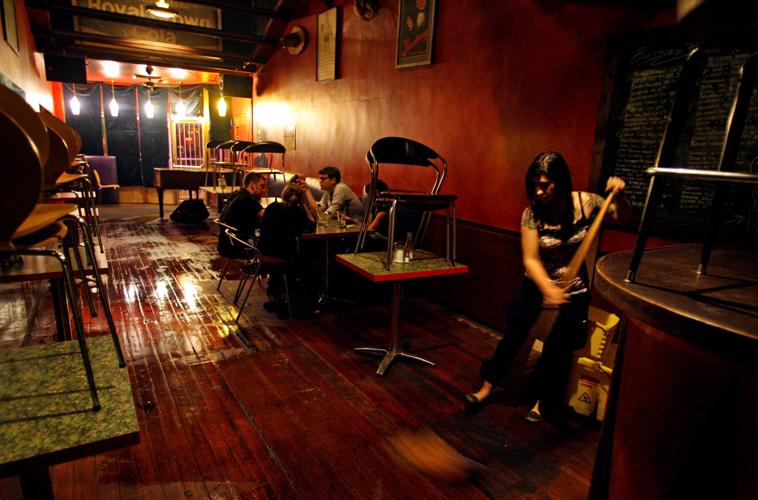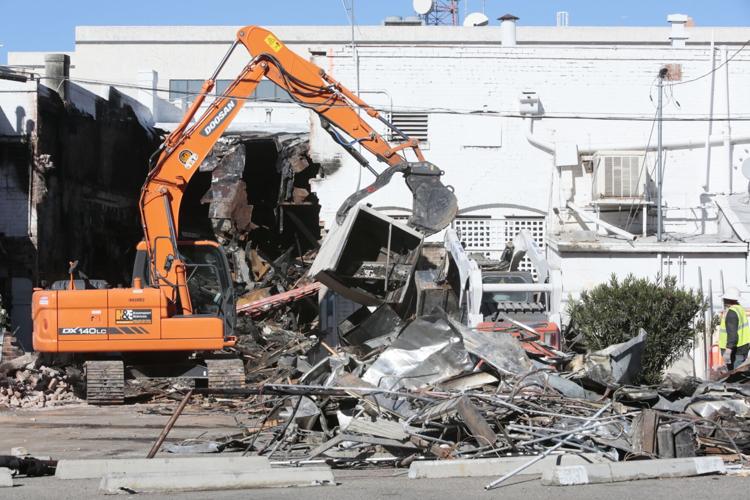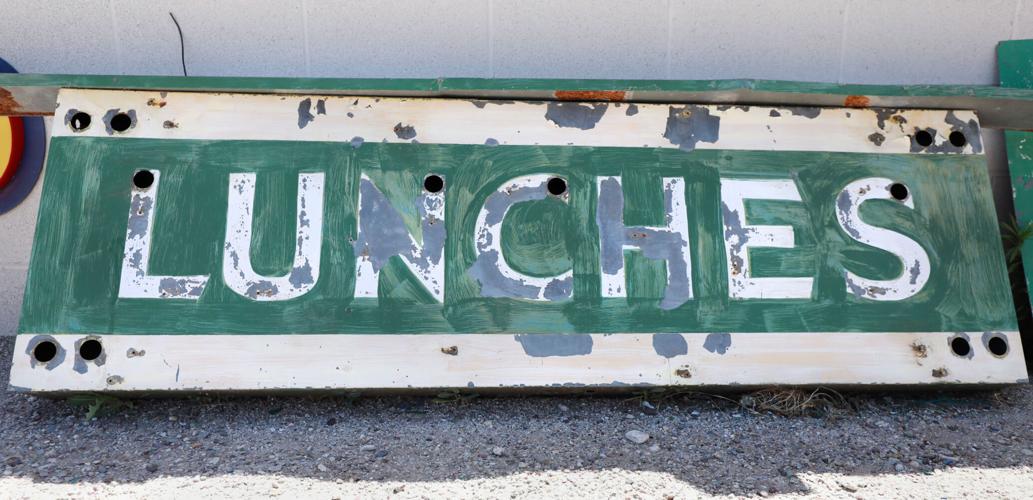The downtown diner at 100 E. Congress took on several names during its 61 years in business: The Stag Grill, Rallis Grill, Congress Grill, and finally just Grill, before its closure in 2011.
Over the years, the food changed, the customer base changed, the businesses surrounding it changed, but one iconic piece of the puzzle remained the same: the rectangular neon “Grill” sign above the restaurant’s front windows and entry way, with “Dinners” in white lettering on a smaller sign to its left, and “Lunches” in the same fashion to its right.
While many of the signs from Tucson’s past have long gone to scrap, the Grill sign has found a new home amid the glowing neon relics at the Ignite Sign Art Museum, 331 S. Olsen Ave.

Ignite Sign Art Museum will prime the Grill sign, paint it, patch any holes in the metal, reinstall the neon and mount it on a faux-storefront facade being built in the museum’s back lot.
Owner Jude Cook acquired the sign from a private residence a couple of years ago. He and his small team of museum volunteers have just recently started the process of bringing it back to its former glory.
“The Grill was a staple,” Cook said. “It was here way before I moved here in ’83. I am delighted to be able to have it, preserve it and restore it.”
Over the next couple of months, Cook, who also owns Cook & Company Signmakers, and his crew plan on taking the sign apart, fixing what needs fixing, and putting it back together again.
They will prime it, paint it, patch any holes in the metal, reinstall the neon and mount it on a faux-storefront facade being built in the museum’s back lot. If all goes according to plan, the sign will be completely restored for viewing by July and hung outside by the end of summer.

Letters from the sign for the Grill were removed so the the main sign could be sanded, primed and painted at the Ignite Sign Art Museum. Each piece of the three-part sign is stripped, sanded and bent back into shape before being painted back to its original green color.
Cook said he believes the Grill sign is original and is one of the older signs with which he has worked. The Stag Grill opened in what was once the Minerva Café in 1950, according to Star archives. Thomas J. Rallis launched the 24-hour diner with restaurateur John J. Paulos for $50,000.
Paulos also owned his namesake restaurant, Paulos, at South Church Avenue and West Congress Street, at the time.
“When I get a sign, I am always expecting the worst,” Cook said. “All things considered, this one is rough, but it is physically in pretty good shape. You can tell parts have been cobbled and hacked. But we aren’t going to have to replace too much metal.”
The Grill sign is one of nearly 400 signs and advertising pieces that can be found at the museum; everything from old General Electric wall clocks and Stroh’s beer wall hangers; to local landmark signs that once beckoned residents to shop, eat and sleep at places like Molina’s Midway, Samaniego House, the Santa Rita Hotel and Jerry’s Lee Ho Market.

The Grill sign is one of nearly 400 signs and advertising pieces that can be found at Ignite Sign Art Museum.
Cook said just about all of the signs that come into the museum require some level of restoration.
“If the condition is already marginalized and they are going to stay outside. I am probably going to restore them,” he said. “If it has a good patina, we just leave it alone. We get it working and put it inside.”
Much of the work at the museum is done on the weekends.
Volunteer Andy Halper spent a recent Saturday scraping the paint off of the Grill’s lettering.
“I am the great paint scraper down there,” said Halper, 53. “I have done so much of it on my own house. I got really good at it.”
Raised in Benson, and a Tucson resident since age 18, Halper originally reached out to Ignite in 2019 after buying the sign that sat outside of Hank’s Coffee Shop in Benson for decade. The sign comprised of the name “Hank’s” on one segment and the words “Coffee Shop” on a second segment shaped like a Hereford steer.
“The sign was iconic in the town because it was so big,” Halper said. “My friend saw it for sale on Craigslist. It is in really rough shape. I started volunteering at the museum to learn about restoration.”
Like the other volunteers, Halper goes where he is needed. He scrapes. He paints. His technical background — Halper is a computer programmer with the United State Geological Survey — means he can help with electrical tasks.
“Jude has a list on Saturday morning of things to do,” Halper said. “He checks things off as we go along.”
Halper said he enjoys volunteering for a museum that brings back such memories for people.
A large Arby’s cowboy hat in the back lot once sat in front of the fast food chain’s location at North Oracle and East Wetmore, where Halper and his grandfather would eat when Halper came to visit.
Halper was even a regular customer at Grill going back to when it was Congress Grill in the early 1990s.

Carrie Hony mops up as she closes down the Red Room at the Grill on Congress Street at 2:33 a.m. in 2006.
“There was a smoking room,” Halper said. “The waitresses had uniforms from the 1950s. It was kind of frozen in time.”
Cook said signs like the Grill sign offer something for everyone.
“You get a little more passion from local visitors because they’ll have a memory of it,” Cook said. “Out-of-towners didn’t grow up with it, by they still can appreciate the craftsmanship that goes into it.”
Cook said he spends so much time working to preserve these signs because they are part of the character of the city.

The downtown diner at 100 E. Congress took on several names during its 61 years in business: The Stag Grill, Rallis Grill, Congress Grill, and finally just Grill, before its closure in 2011.
“I would rather have them out in the community than in a museum,” Cook said. “But if they are going to come down, at least we can preserve them for people who have never had a chance to see them.”

The downtown diner at 100 E. Congress took on several names during its 61 years in business: The Stag Grill, Rallis Grill, Congress Grill, and finally just Grill, before its closure in 2011.
Visual series: Tucson's Neon Culture
What better way to light up the night than a safe, controlled ignition of a gas! Arizona Daily Star photographer Kelly Presnell revisited neon signs that dot the landscape in Tucson. Many are a throwback to a time when a handful of longtime restaurants, hotels and bars served a smaller city.
Neon is the second lightest gas, after helium. It's more expensive than gases because it's extracted from liquid air. It was introduced in the U.S. in 1923 with two signs at Packard dealership in Los Angeles. Its reddish-orange glow warms the darkness surrounding the signs.
Thanks to the efforts of many businesses, residents, sign shops, the City of Tucson and the Tucson Historic Preservation Foundation, neon is once again igniting the night with a cursive glow.
Arizona Daily Star photographer Kelly Presnell revisited neon signs that dot the landscape in Tucson. Many are a throwback to a time when a ha…
Arizona Daily Star photographer Kelly Presnell revisited neon signs that dot the landscape in Tucson. Many are a throwback to a time when a ha…
Arizona Daily Star photographer Kelly Presnell revisited neon signs that dot the landscape in Tucson. Many are a throwback to a time when a ha…
Arizona Daily Star photographer Kelly Presnell revisited neon signs that dot the landscape in Tucson. Many are a throwback to a time when a ha…
Arizona Daily Star photographer Kelly Presnell revisited neon signs that dot the landscape in Tucson. Many are a throwback to a time when a ha…
Arizona Daily Star photographer Kelly Presnell revisited neon signs that dot the landscape in Tucson. Many are a throwback to a time when a ha…
Arizona Daily Star photographer Kelly Presnell revisited neon signs that dot the landscape in Tucson. Many are a throwback to a time when a ha…
Arizona Daily Star photographer Kelly Presnell revisited neon signs that dot the landscape in Tucson. Many are a throwback to a time when a ha…
Arizona Daily Star photographer Kelly Presnell revisited neon signs that dot the landscape in Tucson. Many are a throwback to a time when a ha…
Download a pdf of the Tucson Historic Preservation Foundation guide to the notable neon signs in the Old Pueblo.


